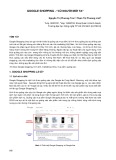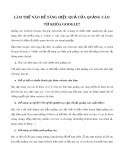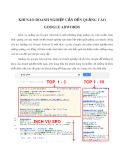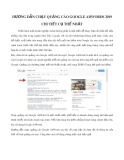
Brought to you by: SEMrush & HubSpot
CHECKLIST
THE ULTIMATE ADWORDS
CAMPAIGN KIT

CHECKLIST: HOW TO RUN ADWORDS CAMPAIGNS
Brought to you by: SEMrush & HubSpot
GOAL DEFINITION
Define your campaign goal and set an expected metric to hit. Defining goals will help you to determine how
successful your campaign was. Is your goal to increase your subscriber list, sales, or sign ups? Be specific.
COMPETITIVE ANALYSIS
Analyze what your competitors do in terms of PPC for similar topics you’re going after. Check out their ads in
Google, look for keywords they’re going after, and think about what you could be doing differently to attract even
more visitors. It’s essential that you don’t simply estimate your competitor’s strategies. Instead, thoroughly analyze
your competitors’ PPC work. For extra help, consider using competitive intelligence tools like SEMrush.
AUDIENCE DEFINITION & CAMPAIGN SETTINGS
Make sure your location, device, and time targeting are set to reach the right people at the right time in the right
place. Remember that you should target different audiences at each stage of the buyer’s journey. You can define
your audience at both the campaign and ad group level.
KEYWORD RESEARCH
The success of any ad campaign depends on thorough keyword research. Start at a high level and search for all
relevant keywords, then choose the most relevant search terms with your ideal parameters (like volume, density,
CPC, etc.). Make sure to include long-tail keywords in your list as well broader, short-tail keywords.
SETTING BUDGET
Define your total and daily campaign budget. Keep in mind: you pay for all the clicks you get to your ads. Budget
accordingly.
CONVERSION TRACKING SETUP
Make sure you are tracking the conversions that are most relevant to the goals you’ve set. Set up Adwords
Conversion Pixels to place on your confirmation pages or import Goals from Google Analytics so you have full
visibility into how your campaigns are converting once they launch.
CAMPAIGN PRE-LAUNCH ACTIVITIES

CHECKLIST: HOW TO RUN ADWORDS CAMPAIGNS
Brought to you by: SEMrush & HubSpot
CAMPAIGN ORGANIZATION / NAMING
Separate campaigns should be built based on a number of factors that depend on your product, website, and goals.
For example, you might need to split campaigns by Region, Language, Goal, Product/Service, or Brand vs. Non-
Brand keywords. When in doubt, mirror the structure of your campaigns with how your website is set up!
GROUPING KEYWORDS IN AD GROUPS
Campaign structure doesn’t have a one-size-fits-all solution. However, we suggest using ad groups to organize your
ads by a common theme. For example, try sorting ad groups by the type of product or service you offer. Limit the
number of keywords you use in each ad group. As a best practice, use only one keyword per ad group.
MANAGING CROSS-GROUP NEGATIVES
Sometimes, you’ll notice that some of your ads might actually be competing with one another. This happens, but try
to avoid it. To do so, add cross-group negative keywords to the appropriate ad groups to set parameters around
which ads appear for specific search terms and which ones do not.
CREATING ADS
Writing compelling copy with a clear and prominent call-to-action is crucial to the success of your ads. Don’t forget
to align with Google’s requirements for the number of characters you can use in each line.
ORGANIZING YOUR CAMPAIGN

CHECKLIST: HOW TO RUN ADWORDS CAMPAIGNS
Brought to you by: SEMrush & HubSpot
AD EXTENSIONS
Get the most out of your spend and include every ad extension that is relevant to your business (like location,
telephone, address, etc.). Google can add up this information to each of your ads when showing them to users at
no additional cost to you.
DETERMINING BIDS
Bid more on keywords that you expect to have a higher click-through-rate, like branded and exact match terms. If
you are not sure what results to expect from a keyword, allocate less spend when you’re starting out. Once you see
how an ad performs, you can allocate more budget if you see fit.
SET UP A/B TESTING
If you’re testing multiple ads, set up your ad group accordingly and set an ad rotation that ensures that you will get
sufficient data on each.
KICK OFF YOUR CAMPAIGN!
Double check everything and launch your campaigns. From here on out, set a daily, weekly, and monthly schedule
to check the progress fo your ads.

CHECKLIST: HOW TO RUN ADWORDS CAMPAIGNS
Brought to you by: SEMrush & HubSpot
CHECK YOUR BUDGETS
Keep an eye on the progress of your campaigns each day by checking your overall spend vs. conversions. Doing so
will help you to see whether the campaign is performing as planned or if you need to make adjustments.
ADJUSTING BIDS
When you track the progress of your campaigns, make sure to adjust your bids for the top performing ads
accordingly to get the most out of the campaign.
CHECKING SEARCH TERMS
Use the Search Terms Report in AdWords to monitor the actual search queries your ads are showing for. Sometimes,
especially with Broad and Phrase Match keywords, Google will show your ads to similar but irrelevant search
queries. If you see any of these in your Search Terms Report, add them as cross-group negative keywords to make
sure it doesn’t happen again!
RUNNING YOUR CAMPAIGN - DAILY
WEEKLY CHECK-IN
CHECKING AND RESEARCHING KEYWORDS
Monitor which keywords are still performing well and which should be replaced with new ones. If a campaign, ad
group, or keyword doesn’t perform, don’t waste money waiting for it to work. Instead, adjust your campaigns for new
keywords that perform better.
CREATING NEW ADS/REPLACING POOR PERFORMERS
Analyze campaign performance and replace poor performing ads with new ones. Glean your learnings from top-
performing ads and incorporate what worked well into your adjusted ad campaigns.

![Bài giảng Google Ads [mới nhất]](https://cdn.tailieu.vn/images/document/thumbnail/2022/20220712/phamvananh1991/135x160/3391657615973.jpg)

















![Bài giảng Thiết kế thông điệp ThS. Lê Anh Phương [chuẩn SEO]](https://cdn.tailieu.vn/images/document/thumbnail/2026/20260105/ocxaodua999/135x160/86921767597063.jpg)






